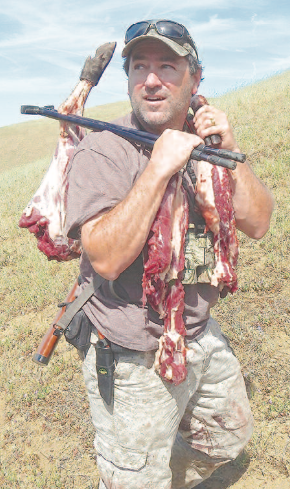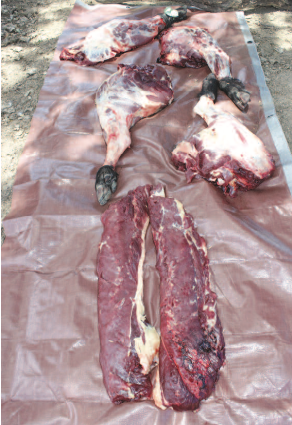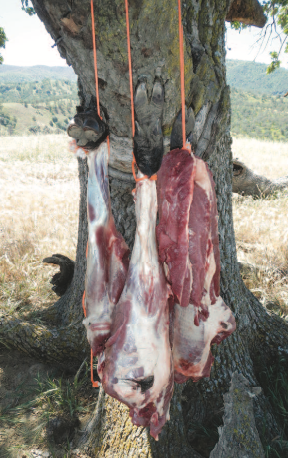
BY TIM E. HOVEY
1 – LOOK FOR SHADE

Depending on the weather and time of day, before I pull out the knives I’ll look for a shady place I can drag the animal to help keep the entire process cooler. Shaded areas will give me a little more time to break down the animal and keep the meat from sitting in direct sunlight. My number one priority after the shot is to take care of that animal and to keep the meat as cool as possible.
If no shade is available and the air temperature is warmer than I’d like, I’ll create a small lean-to using a tarp from my pack to at least keep the processed meat cool during the process. In my opinion, anything I can do to keep the meat out of direct sunlight is worth doing.
2 – THINK BEFORE YOU CUT
I am not a trophy hunter. However, there have been a cou- ple of times in the field where I have regretted not taking a minute or two to think about the field dressing process. Once you start cutting, you can’t go back. If you want to cape out an animal for a specific type of mount, you need to skin the animal in a specific way. This thought process needs to occur before the blades come out.
If you want a shoulder mount of the animal, or want to pre- serve the pelt or hide, you need to plan for this before you field dress the animal. If you’re unfa- miliar with this process, there are dozens of excellent videos online that can assist you in making the right cuts once the animal is down. To avoid having the meat spoil, this decision needs to be made quickly.
3- GUTLESS OR TRADITIONAL
For the last 15 years, I’ve been processing my big game animals using the gutless method. I find it quick, easy and it eliminates the need to expose the meat or yourself to the animal’s entrails. It involves skinning the four limbs and removing them from the body of the animal quickly. You can then skin the back and remove the back straps. It’s what I’m used to, and I can usually part out the animal in about 30 minutes.
If it’s hot out, you may opt for opening the gut cavity and removing the entrails. Most of the animal’s body heat is contained in the entrails and if you’re looking to cool down the animal quickly, removing the guts is the best way.
4- HANG MEAT TO COOL

Once you remove the meat from the animal, it’s very important to let it cool down. I carry a small tarp in my pack so that I can place each quarter and the back straps on a clean surface to cool down. Ideally, you want to hang the meat in the shade of a nearby tree. This allows the ambient air to circulate around the meat cooling down the entire piece.
If I have game bags, I’ll place each quarter in a bag and hang it from a nearby tree. The bags help in keeping flies, bugs and dirt off the meat, as well as keeping it cool. Game bag or not, I will always hang the meat while I’m field dressing big game to help keep the quarters cool.
5- COOLER TIME – KEEP IT DRY
Once you get back to your truck or camp, it’s time to load the meat into a cooler. While it’s important to continue to cool down the meat, hunters should avoid getting the game meat wet. If your cooler has a slurry of water and ice in it, dump out the water and gather up the remaining ice and place it in Ziploc bags. Place the bagged ice on the bottom of the cooler and then place the bagged meat on top of the bags.
A better way to charge a cooler for storing game meat is to fill several plastic containers with water and place them in a freezer prior to the hunt. Putting these frozen containers in the cooler will keep it cold and will eliminate the excess water in the cooler. This cooler set up is the ideal way to store game meat for a prolonged period.



